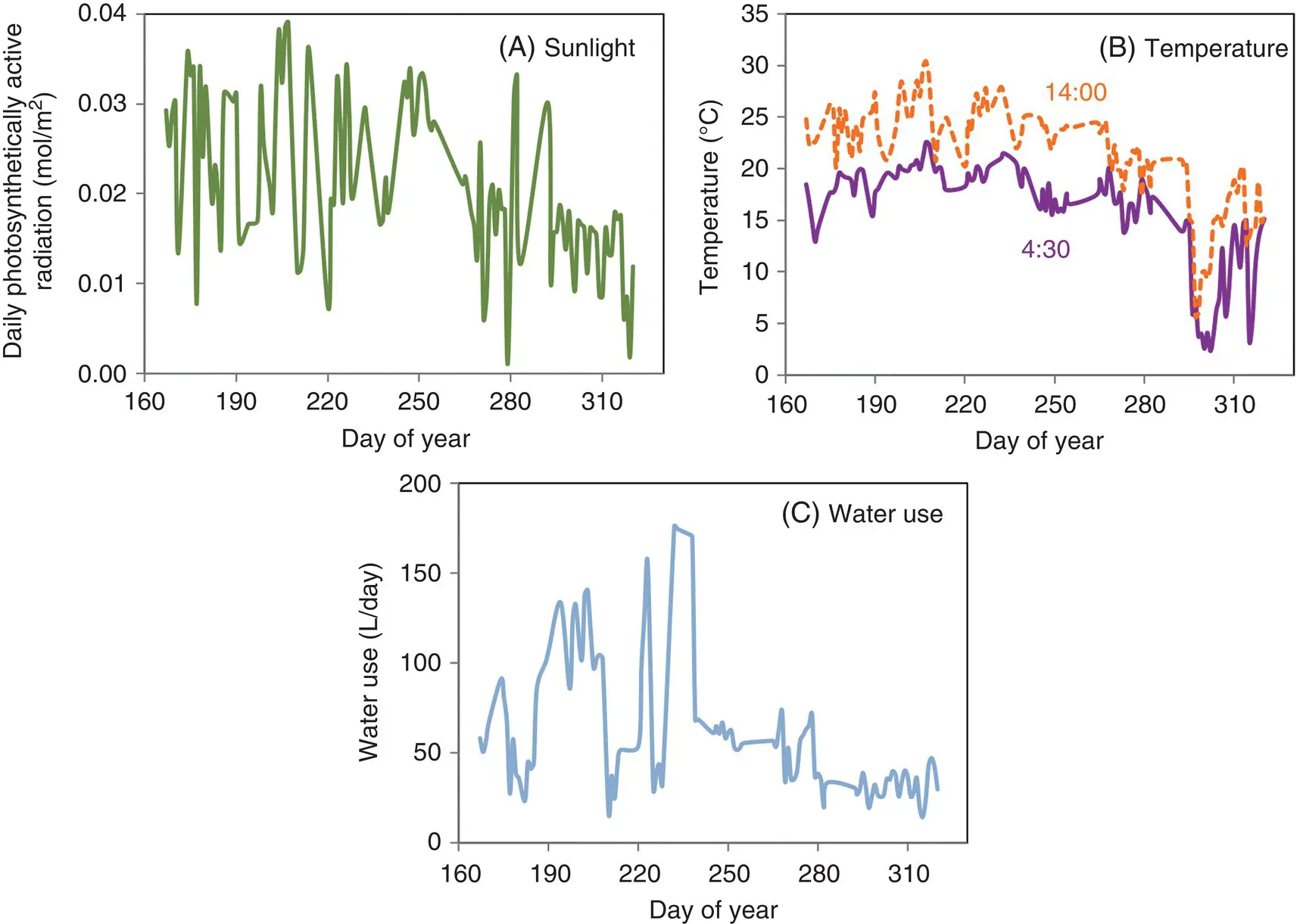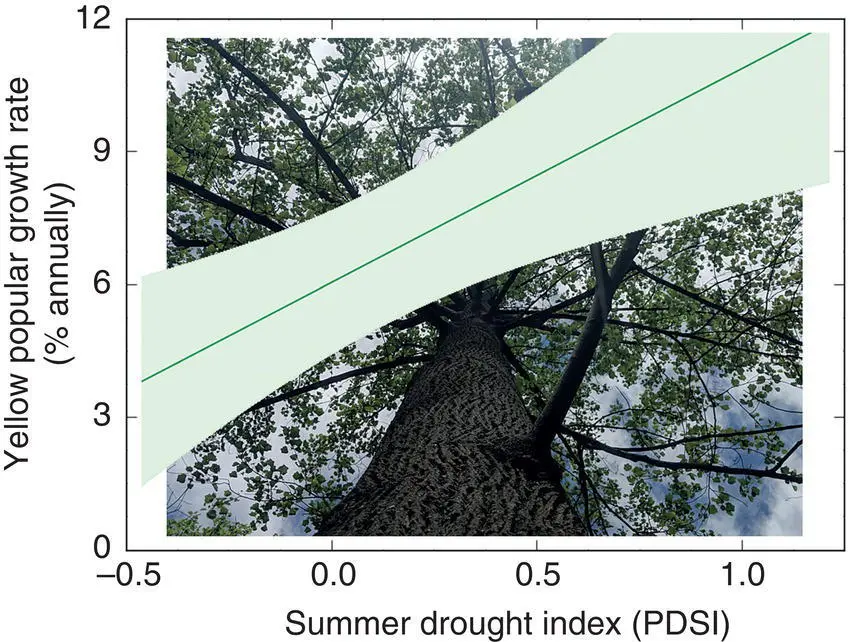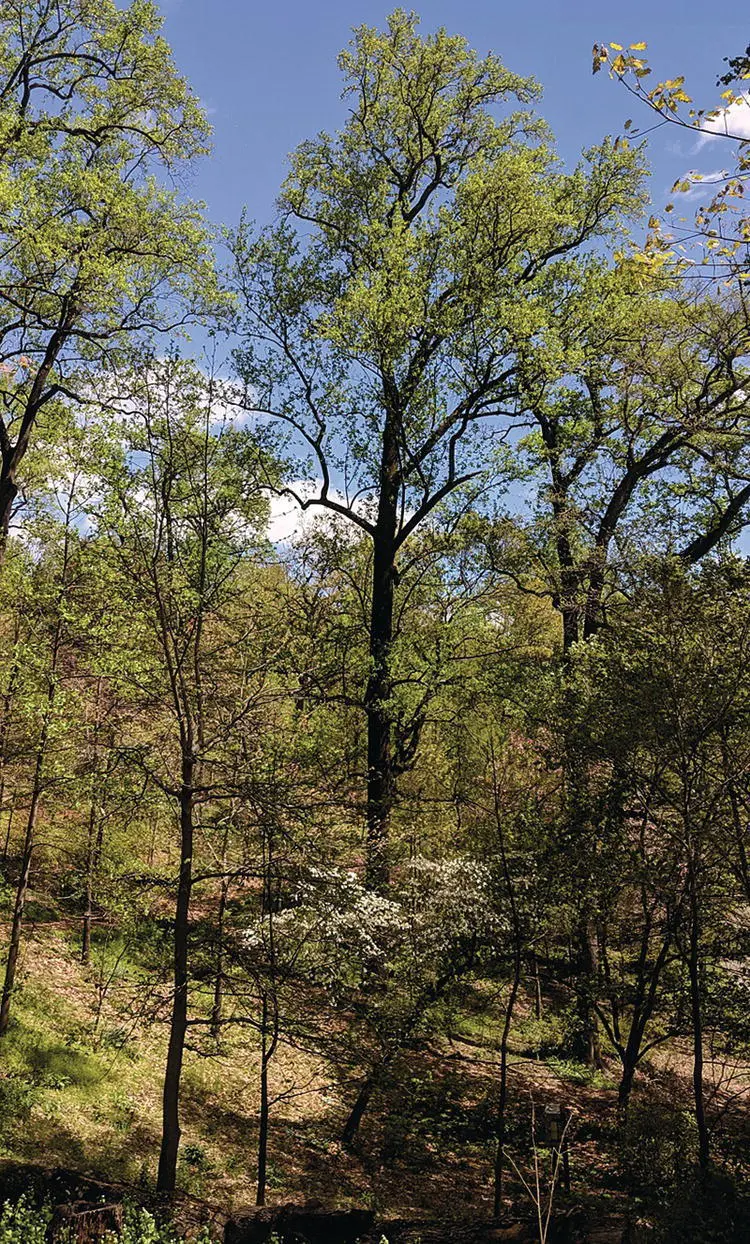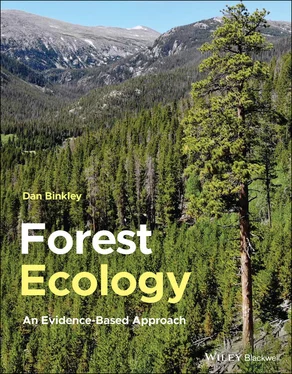Dan Binkley - Forest Ecology
Здесь есть возможность читать онлайн «Dan Binkley - Forest Ecology» — ознакомительный отрывок электронной книги совершенно бесплатно, а после прочтения отрывка купить полную версию. В некоторых случаях можно слушать аудио, скачать через торрент в формате fb2 и присутствует краткое содержание. Жанр: unrecognised, на английском языке. Описание произведения, (предисловие) а так же отзывы посетителей доступны на портале библиотеки ЛибКат.
- Название:Forest Ecology
- Автор:
- Жанр:
- Год:неизвестен
- ISBN:нет данных
- Рейтинг книги:5 / 5. Голосов: 1
-
Избранное:Добавить в избранное
- Отзывы:
-
Ваша оценка:
- 100
- 1
- 2
- 3
- 4
- 5
Forest Ecology: краткое содержание, описание и аннотация
Предлагаем к чтению аннотацию, описание, краткое содержание или предисловие (зависит от того, что написал сам автор книги «Forest Ecology»). Если вы не нашли необходимую информацию о книге — напишите в комментариях, мы постараемся отыскать её.
Forest Ecology
An Evidence-Based Approach Forest Ecology: An Evidence-Based Approach
Forest Ecology: An Evidence-Based Approach
Forest Ecology — читать онлайн ознакомительный отрывок
Ниже представлен текст книги, разбитый по страницам. Система сохранения места последней прочитанной страницы, позволяет с удобством читать онлайн бесплатно книгу «Forest Ecology», без необходимости каждый раз заново искать на чём Вы остановились. Поставьте закладку, и сможете в любой момент перейти на страницу, на которой закончили чтение.
Интервал:
Закладка:
Source:Data from Chelcy Miniat.
Trees Must Cope with Seasonal Cycles Through Each Year
The environment surrounding the tulip poplar changes through the course of a year. The daily cycles of temperature swing between 5 and 10 °C, while the coldest and warmest day of the year may differ by 25 °C or more ( Figure 1.3). Incoming sunlight in winter averages about half the level experienced in summer, as a result of shorter days, lower sun angles, and fewer clouds. These environmental changes lead to regular, predictable patterns in the phenology of the tree.
The tulip poplar begins an annual cycle of flowering and growth with the initiation of root growth late in the winter, followed by flowering in April and May. The tulip‐shaped flowers are pollinated by bees and other insects, with 10 000 seeds raining from the crown in autumn. The leaves of the crown also expand in April and May, from expanding buds that were set the previous year. The initial burst of leaf growth depends on stored sugar, but the leaves rapidly provide new sugar for their own growth, and for the growth of all parts of the tree. The growth of a new leaf requires only about one‐week's production of sugar; the rest of the span of the leaf's existence contributes to the growth and maintenance of other tissues.
Over the course of the growing season, the tulip poplar may produce 50 kg of sugar. Respiration would consume half, and the growth of short‐lived roots and leaves might consume another quarter. Less than 25% of the annual production from the tree's leaves would be found in new stem wood, increasing the diameter and height of the tree. The annual growth of the tree might use more than 8000 liters of water.
Dry periods during the summer lower the rate of photosynthesis in two ways. Low supplies of water in the soil lead to closure of leaf stomata, restricting both the gain of CO 2and the loss of water. The tulip poplar might also respond directly to the dryness of the atmosphere, and days with very high vapor pressure deficits may have low rates of photosynthesis, even if the soil is moist.
Trees Grow and Reproduce at Times Scales of a Century
Tulip poplar trees originate from seeds that develop following pollination of a flower by a bee or other insect. The flower may have developed on a parent tree as young as one or two decades, or as old as one or two centuries. Seeds develop over a period of five or six months, and then fall to the ground within a radius equal to a few times the height of the parent tree. A single seed may germinate the following summer, or several summers later. The vast majority of seeds may never germinate, or if they germinate may not lead to a successfully established seedling. New seedlings require a great deal of luck to establish, including obtaining enough water and nutrients from the soil to support the development of leaves, and enough sunlight (perhaps 10% of full sun) to drive photosynthesis. The full intensity of sunlight may dry out a seedling, or overwhelm the photochemistry of new leaves.

FIGURE 1.3 Seasonal trends in incoming sunlight (A) lead to almost twofold differences between summer and winter. The difference might be larger if not for the frequent cloud cover in summer. Patterns in incoming light lead to both daily and seasonal patterns in air temperatures (B). These environmental driving forces combine with the biology of the tulip poplar to determine the seasonal course of water use by the tree (C).
Source:Data from Chelcy Miniat.

FIGURE 1.4 Growth of yellow poplar trees is low in drier summers (a negative value for the Palmer Drought Severity index), and increases with increasing summer moisture.
Source:Data from Kardol et al. 2010.
A tulip poplar stem may not be the “first generation” of the “tree.” A tree stem may die (from a wind storm breaking the stem, or a saw harvesting the tree), and a new stem may develop from dormant buds in the stump. The early growth and development of sprouted stems is faster and more assured than the tenuous development of a new seedling.
Weather differs a lot from one year to the next, and the growth of the tree during favorable periods may be double the growth rate for droughtier times ( Figure 1.4). This response of an individual tree is the outcome of several factors, including the direct effects of the environment on this tree's physiology, and the indirect effects of how fluctuations in the environment change the competition between trees in the forest.
The tree is larger than its local neighbors, and this “dominance” provides a twofold advantage. The tree obtains a higher supply of light, water, and nutrients than its neighbors, driving faster growth. Faster growth then leads to a positive feedback that increases the tree's capture of resources, allowing its growth to increase at the expense of neighbors.
The Story of Forests Is More than the Sum of the Individual Trees, Because Interactions Are So Strong
The tulip poplar tree is enmeshed in a complex ecological system ( Figure 1.5). The tree provides habitat for an intricate community of insects and other arthropods. Each kilogram of leaves supports a total arthropod community of about 1 g (Schowalter and Crossley 1988), so the total leaf mass of the crown of 25 kg would support about 25 g of arthropods. Some of these invertebrates feed on the tree, eating leaves (or the insides of leaves), sucking sap, and boring into the wood of branches and the stem. Occasionally the populations of tree‐feeding insects might increase to the point where much of the forest canopy is eaten; in most cases trees survive defoliation by native insect herbivores and form new canopies in the same season. Forests have other arthropods that feed on the species that feed on trees, forming complex food webs that include small mammals, a dozen or more species of birds, and even fish in streams and ponds that feed on arthropods from within the forests.

FIGURE 1.5 The dominant tulip poplar tree in the center of this springtime photo is part of a complex ecological system that includes other tulip poplars, other trees from more than a dozen species, several dozen species of understory plants, hundreds of species of arthropods and other invertebrates, and a soil that is itself a complex system with a level of biodiversity that dwarfs the diversity of the rest of the forest.
Does the tree benefit from neighbors, or is competition for resources the major effect of neighbors? Competition between trees is very important in all forests, but some possibilities exist for interactions between trees that actually benefit neighbors. One example is having a nitrogen‐fixing black locust tree as a neighbor. The tulip poplar would compete with the locust for light, water, and other nutrients, but it might benefit from the enrichment of the soil N supply by the locust. Dozens of species of plants in the understory also compete with overstory trees for soil water and nutrients.
The diversity of plant species may be impressive, but this diversity is overshadowed by the diversity of invertebrates. Each square meter of soil contains about 60 large invertebrates with a total mass of about 1 g (Seastedt and Crossley 1988). The number of small invertebrates would be on the order of 10 000 individuals (from hundreds of species) in each square meter; most of these feed on soil fungi.
Читать дальшеИнтервал:
Закладка:
Похожие книги на «Forest Ecology»
Представляем Вашему вниманию похожие книги на «Forest Ecology» списком для выбора. Мы отобрали схожую по названию и смыслу литературу в надежде предоставить читателям больше вариантов отыскать новые, интересные, ещё непрочитанные произведения.
Обсуждение, отзывы о книге «Forest Ecology» и просто собственные мнения читателей. Оставьте ваши комментарии, напишите, что Вы думаете о произведении, его смысле или главных героях. Укажите что конкретно понравилось, а что нет, и почему Вы так считаете.












